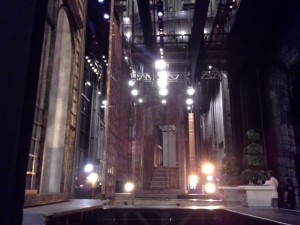 First off, huge correction to an old post. It’s, what, my fourth? And I’m already correcting and retracting. How’s that for establishing credibility? In the Stagehand View dated December 23, 2013, I missed a huge typo that changed the meaning of a very important sentence. Here’s what I wrote on the day I shamed myself:
First off, huge correction to an old post. It’s, what, my fourth? And I’m already correcting and retracting. How’s that for establishing credibility? In the Stagehand View dated December 23, 2013, I missed a huge typo that changed the meaning of a very important sentence. Here’s what I wrote on the day I shamed myself:
“I get the sense they feel a union member who doesn’t come to meetings is sufficiently committed to the cause.”
Here’s what I meant to say:
“I get the sense they feel a union member who doesn’t come to meetings isn’t sufficiently committed to the cause.”
The latter sentence is how the post now reads. My apologies for what must have seemed liked, at best, a non-sequitur.
It’s funny how the human eye and brain conspire to show us what we expect to see of the world. I just checked the number of times I revised that December 23rd post: I saved twelve drafts. That means I read that sentence, with its huge mistake, at least a dozen times. And I’m a pretty decent editor! Except when it comes to my own writing.
Look at that! Already bumping up against two hundred words and not even a mention of Robert’s Rules of Order. I’m getting good at this, huh?
Today’s Lesson:
I think I promised to start describing all the different motions. So that’s what you’re stuck with today.
Business is brought before an assembly by the motion of a member. A motion may itself bring its subject to the assembly’s attention, or the motion may follow upon the presentation of a report or other communication. (p. 26, lines 14-18)
The thing to keep in mind from this quote is that whoever wrote it had trouble expressing him or herself in a written medium. …
Seriously though, it doesn’t say anything about a motion “following upon” the protracted musings of one or more members. Motions start discussions at a meeting. And usually they take the form of “main motions.” To quote Robert, “The main motion sets a pattern from which all other motions are derived.” (p. 27, lines 1-2) Most of the motions anybody ever makes at a union meeting are main motions with the intention of getting the local to do something, anything. They didn’t get dubbed ‘motions’ because they’re intended to grind the meeting to a halt, despite what you may have personally witnessed.
All of this is not to say you can’t or shouldn’t ask questions. It’s every members’ responsibility to understand what the local’s doing. And when they don’t, they should ask questions until they do. There are even parliamentary guidelines dictating how this should be done. I’m not going to talk about a single one of them. You are more than welcome to learn them and let them be your guide. But I’ve never cared enough to bother learning them. I haven’t needed to. Local 205 is a pretty small deliberative assembly with a tradition of informality at its meetings that I think fits it well. Most of the time.
As my first quote of the day indicates, motions are often responses to reports “or other communication.” For example, the education committee could give a report at a meeting highlighting the fact that we have apprentices but no apprentice training program. They could present the case that this is, at the least, an unethical stance for a union local to maintain. In response to this, a member could make a motion to immediately promote all the local’s apprentices to journeymen because it’s unfair to sentence them to three year probations without offering them the means to attain full membership status. Or, even better, the committee itself could have ended its report with such a motion. This would have cut out the need for an individual member to make it or second it. (Since a committee is made up of more than one person, it’s always assumed it seconds any motions it makes). Then folks could talk about it and hopefully vote on it.
After that enlightened motion passed, a member could follow up by making another one to amend our constitution to delete any mention of apprentices or apprenticeships. Of course, special rules would apply to this specialized motion. For example, it would have to be in writing and be read at three consecutive meetings before we could pass it. But we’d be well on the way to giving the new VP a blank canvass on which to paint the Local 205 education program.
How do you like my hypothetical example which I made up for purely educational purposes? No hidden agendas at work here, I assure you. Well, nothing hidden anyway.
But seriously, I hope this little exploration of the main motion has helped. Look for more on Robert’s Rules of Order next week. And who knows what else.
 Happy Monday! I hope your holiday season is going exactly according to plan. Mine’s been lovely, relaxing, and productive all at once. Another
Happy Monday! I hope your holiday season is going exactly according to plan. Mine’s been lovely, relaxing, and productive all at once. Another  But enough happiness and gratitude, let’s talk
But enough happiness and gratitude, let’s talk  Back to motions. They help us by keeping us focused on only one item of business at a time. They’re hierarchical. Certain motions take precedent over others. Some motions are debatable, some require a second and some don’t. Their interactions can get complex. Though that depth of parliamentary knowledge rarely comes into play for organizations like Local 205. It’s important to keep something in mind when learning the basics of Robert’s Rules of Order: as Brother Charlie Haymes put it, “Everything you need to know about Robert’s Rules of Order is in the first quarter inch.” He had something pithy to say about the remaining inch and a half of the book as well. But I’m pretty sure I’ve already misquoted him so I’ll stop. Even Robert’s Rules, in its preface, councils the novice to concentrate on the first five chapters. For now, just remember this about motions: A motion begins discussion, not the other way around. Do not be fooled by the deplorable habits of this local. It’s bad form to stand up and blather on about some idea you might have. Use the motion forms that I applaud the E-board for supplying and make a motion. Assuming it’s seconded, then it’s open for discussion. Not before.
Back to motions. They help us by keeping us focused on only one item of business at a time. They’re hierarchical. Certain motions take precedent over others. Some motions are debatable, some require a second and some don’t. Their interactions can get complex. Though that depth of parliamentary knowledge rarely comes into play for organizations like Local 205. It’s important to keep something in mind when learning the basics of Robert’s Rules of Order: as Brother Charlie Haymes put it, “Everything you need to know about Robert’s Rules of Order is in the first quarter inch.” He had something pithy to say about the remaining inch and a half of the book as well. But I’m pretty sure I’ve already misquoted him so I’ll stop. Even Robert’s Rules, in its preface, councils the novice to concentrate on the first five chapters. For now, just remember this about motions: A motion begins discussion, not the other way around. Do not be fooled by the deplorable habits of this local. It’s bad form to stand up and blather on about some idea you might have. Use the motion forms that I applaud the E-board for supplying and make a motion. Assuming it’s seconded, then it’s open for discussion. Not before. I still hold out hope the next VP will rally our Education Committee and create a local 205 apprentice program. But the new Veep won’t take office until
I still hold out hope the next VP will rally our Education Committee and create a local 205 apprentice program. But the new Veep won’t take office until 
